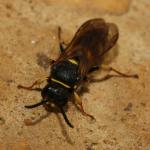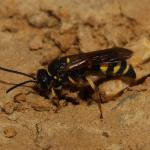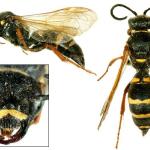Gorytes croceipes Eversmann, 1849; Argogorytes mongolensis Tsuneki, 1971; Argogorytes przewalskyi Kazenas, 1971; Mellinus campestris Fabricius, 1790; Gorytes pleuripunctatus: Dittrich, 1911; Argogorytes hispanicus Yildirim and Ljubomirov, 2005
The scarcer and smaller of our two Argogorytes wasps, but seemingly with a similar biology to A. mystaceus. Often cited as Gorytes campestris (Linnaeus, 1761) in older literature.
Recorded sparingly within England as far north as the Filey-Bridlington district of South-east Yorkshire. Older records from South Wales, and as far west as South Devon. Also found on the Channel Islands. Abroad, this species may be restricted to Europe (Lomholdt, 1975-76).
Listed as Rare RDB3 in Shirt (1987) and as Notable A by Falk (1991) (now known as Scarce (Na)). There is some evidence of a decline in Devon and Dorset, but recent records indicate that the wasp has spread to areas from which it was unrecorded in the past.
Occurs in a variety of open habitats on light soils, including heaths, quarries and gravel pits, river corridors featuring clay or sandy river banks, fixed coastal dunes and soft rock cliffs. Within these it requires features such as vertical earth banks or sparsely vegetated dry ground for nesting, in combination with areas of tall grass or herbs for hunting.
Univoltine; late May to early August.
This wasp preys on frog-hopper nymphs (Homoptera: Cercopidae), especially Philaenus spumarius and Aphrophora alni.
Nests occur in vertical cliffs or sparsely vegetated slopes of sand, clay or gravel, often in the company of eumenid wasps (Odynerus species). Specific nesting locations noted in Britain include river banks, the bases of coastal cliffs and the sides of quarries. Nests can occur in small aggregations. The main nest tunnel runs for 10-20 cm, giving rise to 6-9 cells. These are typically stocked with 18-25 prey items.
Umbellifers such as wild parsnip (Pastinaca sativa) and hogweed (Heracleum sphondylium); also spurges (Euphorbia spp.). On the Continent, Kullenberg (1961) states that males are important pollinators of the fly orchid (Ophrys insectifera).
Attacked by the cleptoparasitic nyssonine wasp, Nysson spinosus and almost certainly (in Britain at least) by the Vulnerable (RDB2) species, N. interruptus, which may be entirely dependent on A. fargeii in this part of its range.
2001
Proofed: March 2012




